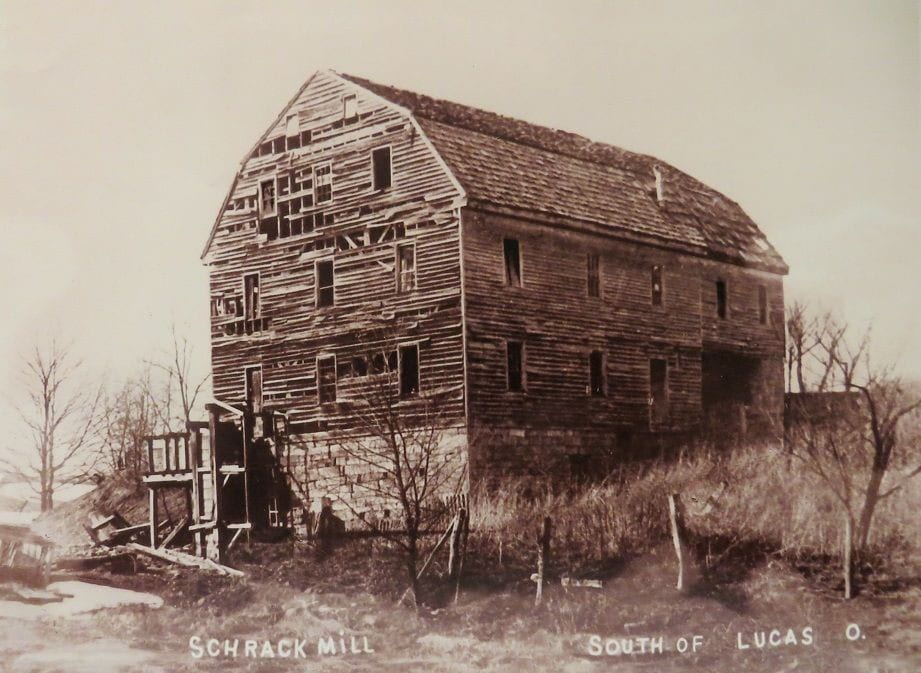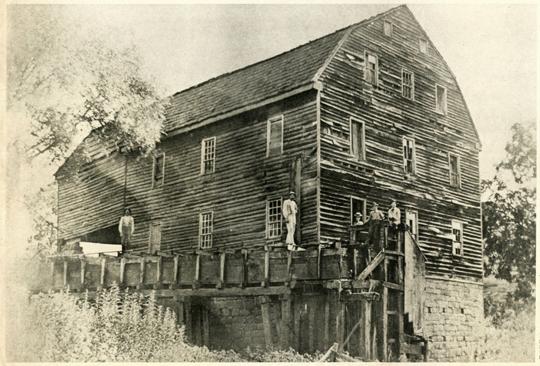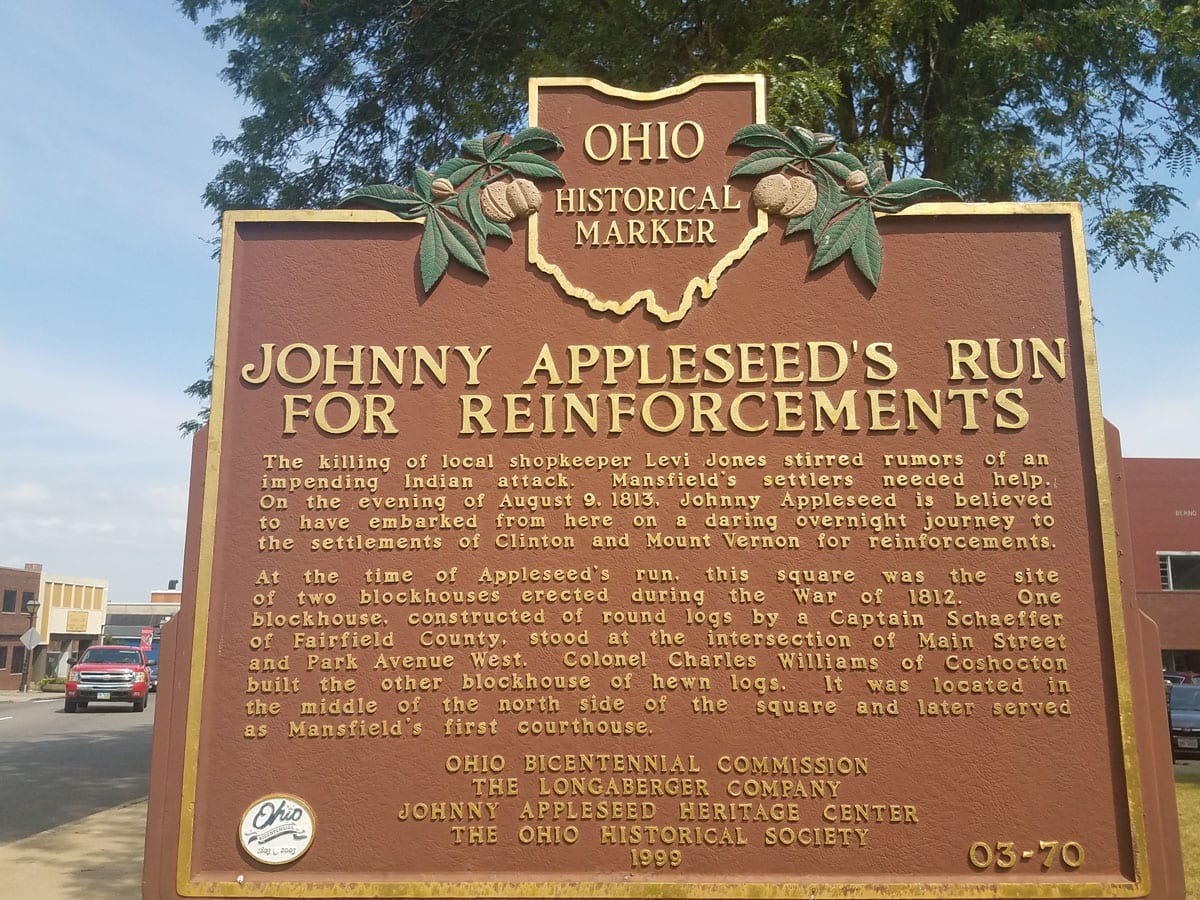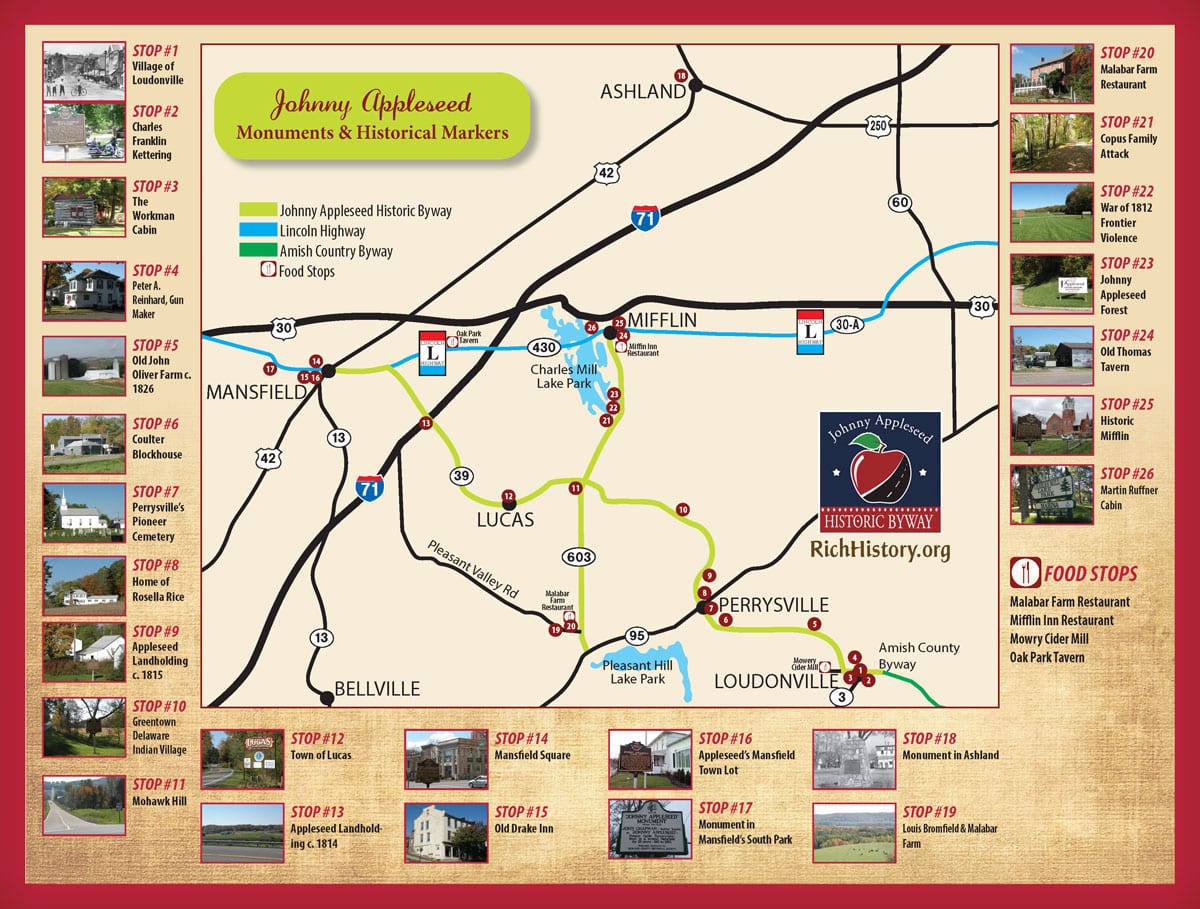Niman Springhouse
The Roadside Market Stand was dedicated “to the memory of Mary Appleton Bromfield, who also loved this valley and found here peace, happiness and abundance.” Louis Bromfield 1952 (Photo of plaque mounted on springhouse wall)
This spring now known at Malabar as the Niman Spring was familiar with the Indians for centuries. Johnny Appleseed frequently stopped here and the water was appreciated by the deer which still come at night fall to drink the water from the pond. The spring breaks out from the deep Silurian sandstone in a small cavern in the hillside and supplies water for the old springhouse , a residence, two stock tanks, the marketstand, a watercress bed, a barn, three hog lots, and the pond from which the gardens are irrigated. The nearby residence was built in 1820 as a combination residence and stagecoach tavern. After the fear of the Indians had been broken forever at the Battle of Fallen Timbers. The fine spring decided its location on the outskirts of Newville. Then the most important settlement in the county, Newville disappeared with the construction of Pleasant Hill Dam. Pleasant Valley Road was once an Indian trail leading from the Ohio River to Lake Erie and later an important means of transporting wheat to ship and railroad. Spring capacity 2,000 gallons per hour with 3 degree change all year. by Louis Bromfield 1952 (taken from the sign mounted on door at springhouse)
The red brick two story farm house still stands today (as the Malabar Farm Restaurant) and the spring water still flows freely just as it did centuries ago. Visitors can stop by and see the spring and farm areas just as it was during Bromfield’s day (1938-1956). The spring fed pond across from the springhouse is stocked with Rainbow trout annually and is open to public fishing. Malabar Farm State Park is only a few minutes drive from Pleasant Hill Lake Park along the Johnny Appleseed Historic Byway on State Route 603 in Richland County Ohio. (Photo of the 1820’s brick farmhouse today) Louis Andres, retired Park Manager of Malabar Farm
Malabar Farm Restaurant
The Malabar Farm Restaurant, located in beautiful southern Richland County, holds a rich history all its own. Completed in 1820 by David Schrack and his sons, the two story home was made from bricks formed onsite. The foundation of the Schrack home was made from hand hewn sandstone blocks quarried just 300 feet from the building. That the four feet thick walls still stand as silent tribute to the dedicated work done by this frontier family over 200 years ago.
The Scracks built their home along one of the busiest routes of the day. Pleasant Valley Road had its roots as an early animal trail, a path used by Native Americans and later an important trade route for young Ohio. This road was part of the Sandusky-Marietta stagecoach route and carried passengers, freight and livestock to and from markets along Lake Erie and the Ohio River. From the Schracks’ home it was a more than 10 hour trip by stage to Sandusky or a short 40 hour journey to Wheeling, West Virginia.
In 1941 the brick home and surrounding property became part of Malabar Farm, The former home of Pulitzer Prize winning author, farmer and conservationist Louis Bromfield (1896-1956) . Bromfield included the Schrack place in his book Pleasant Valley and said he hoped to open a restaurant which featured a French chef. Although Bromfield never opened a restaurant, Bromfield did use the home for his farm workers and the springhouse beside the home as a vegetable stand for fresh farm produce.
The restaurant was opened in 1963 just seven years after Bromfield’s death and has operated since. The State of Ohio took possession of the farm in 1972 and leased the restaurant operations. The restaurant in the spirit of Bromfield’s vision serves French prepared cuisine featuring local meats and produce. The restaurant is open year round closed Mondays with seasonal hours.
Schrack Mill
Charles Schrack chose the site in Pleasant Valley because of Switzer’s Creek: the strong stream that raced through the valley toward the Clear Fork River.
In order to utilize that water power to turn his grinding stones he mounded up an earthen dam that ponded water above the level of the mill. From that mill pond the water could be routed through a long wooden sluice to where it would cascade down and spin the turbine.
Two hundred years ago this was common rural technology, and it was familiar to everyone across the farmlands.
The mill pond, and the “old mill stream,” were commonplace and necessary in rural society as malls and parking lots are today in urban society.
As a frequent destination in early county history the mill was vital not only as a center of commerce and labor, but also as a prime recreational facility. There weren’t any civic pools back then, but there were mill ponds. And in the winter the frozen pond was a tremendously valuable skating rink.
The Schrack Mill, which was run by Ceely Rose’s father David, was later torn down and the foundation stones and beams used in the construction of the Main Barn (Clement Herring Barn) at what is now Malabar Farm State Park.
Celia Rose
One of this region’s most famous legends is the story of Celia Rose, the disturbed young woman who in 1896 poisoned her family and attempted to poison others.
In 1896 Ceely Rose was a young girl who was infatuated with a local man by the name of Guy Berry. Berry didn’t feel the same, but he couldn’t stop Rose’s advances. He eventually told her that they couldn’t be together because her family did not approve of him. This wasn’t true, but Ceely didn’t know that. Enraged, Ceely poisoned some food which she served to her parents and brother. They all ended up dying within just a few days of one another. Ceely was arrested and sent to a mental hospital in Lima, Ohio where she spent the rest of her life.
In 1939 the house and surrounding land was purchased by author Louis Bromfield. Here, he created Malabar Farm. The Rose house is on part of the land still today. The story inspired Bromfield in his writing of the book “Pleasant Valley.”
It is rumored that the Rose home, Malabar Farm, and Pleasant Valley Cemetery are all haunted by Ceely’s ghost. Ceely was buried at the mental hospital in Lima. Pleasant Valley Cemetery is just across the road from Malabar Farm, and is where Ceely’s family, and Guy are buried.
The Rose home is NOT open to the public, and it can easily be viewed from along Bromfield Road though.
Celia Rose, the confessed murderer, as photographed at the Richland County Jail in September of 1896 by a tabloid newspaper from Utica, New York.
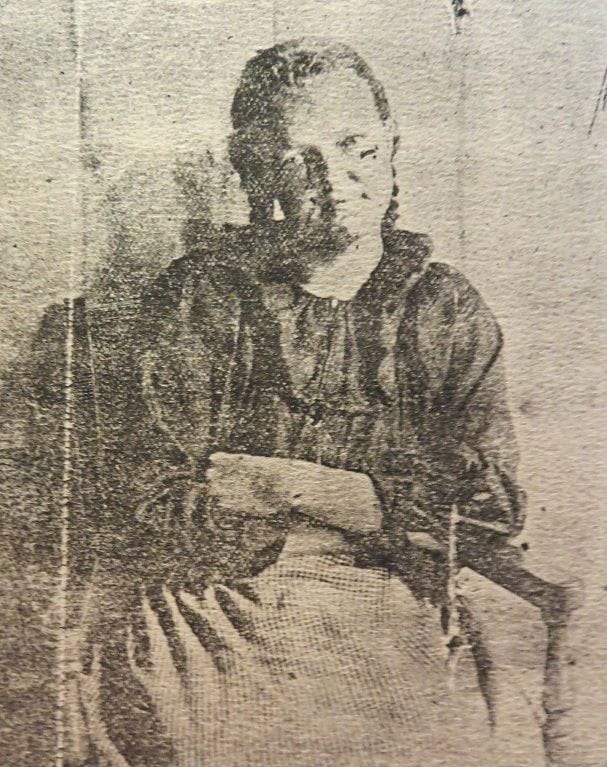
Celia Rose 1896 Photo
Johnny Appleseed
John Chapman, better known as Johnny Appleseed, was a 19th-century horticulturist who made great contributions to the westward expansion of the United States. Though he may not have traveled down the Allegheny River on a block of ice like his folk-hero persona, Chapman paved the way for countless frontiersmen to settle new land around his orchards.
Chapman, the son of a farmer, was born on September 26, 1774 in Leominster, Massachusetts. He moved to Ohio at the beginning of the 19th century, bringing seeds from Pennsylvania cider presses with him and planting them along the way. Though his legend may paint a picture of Johnny Appleseed planting at random and selflessly handing out seeds to needy settlers, in reality Chapman’s path followed a strategic business plan. Children’s books about Appleseed have, of course, removed the element of alcohol from the story, but Chapman’s success was centered not around fresh apples but rather the cider they could create. Cider was an essential at the American dinner table at the time, so most homes had their own small orchard. Chapman planted orchards along the pioneers’ routes, staying ahead of other orchardist competition since his nomadic, unmarried lifestyle allowed him to cover more ground. He would then trade his seedlings with new settlers in the area so that they could grow apples for their new homes.

The Johnny Appleseed Historic Byway is a 31-mile route made up of Ohio 39 from Loudonville, northwest through Perrysville and Lucas and ending in Mansfield; and Ohio 603 from Mifflin to Malabar Farm. Pick up a Byway brochure at local Visitors Bureaus and Pleasant Hill Lake Park office located on State Route 95 in Perrysville,Ohio.
Clear Fork Gorge
A Feature of Ohio’s Forests
Clear Fork Gorge was formed when the glacial melt waters cut through the sandstone bedrock that forms its steep walls fourteen to twenty-four thousand years ago. The gorge is one thousand feet wide and over 300 feet deep. Its seclusion has preserved a rare forest community that includes native white pine and towering eastern hemlock. A national Natural Landmark, the gorge displays a wide variety of other tree species more common throughout the state, with sycamore on the bottomland, beech, ash, and tulip popular father up the slope, and oak and maple on the ridge above. The gorge has changed little since pioneer legend Johnny Appleseed tended his apple orchards nearby. Photo of Louis Bromfield overlooking the gorge.
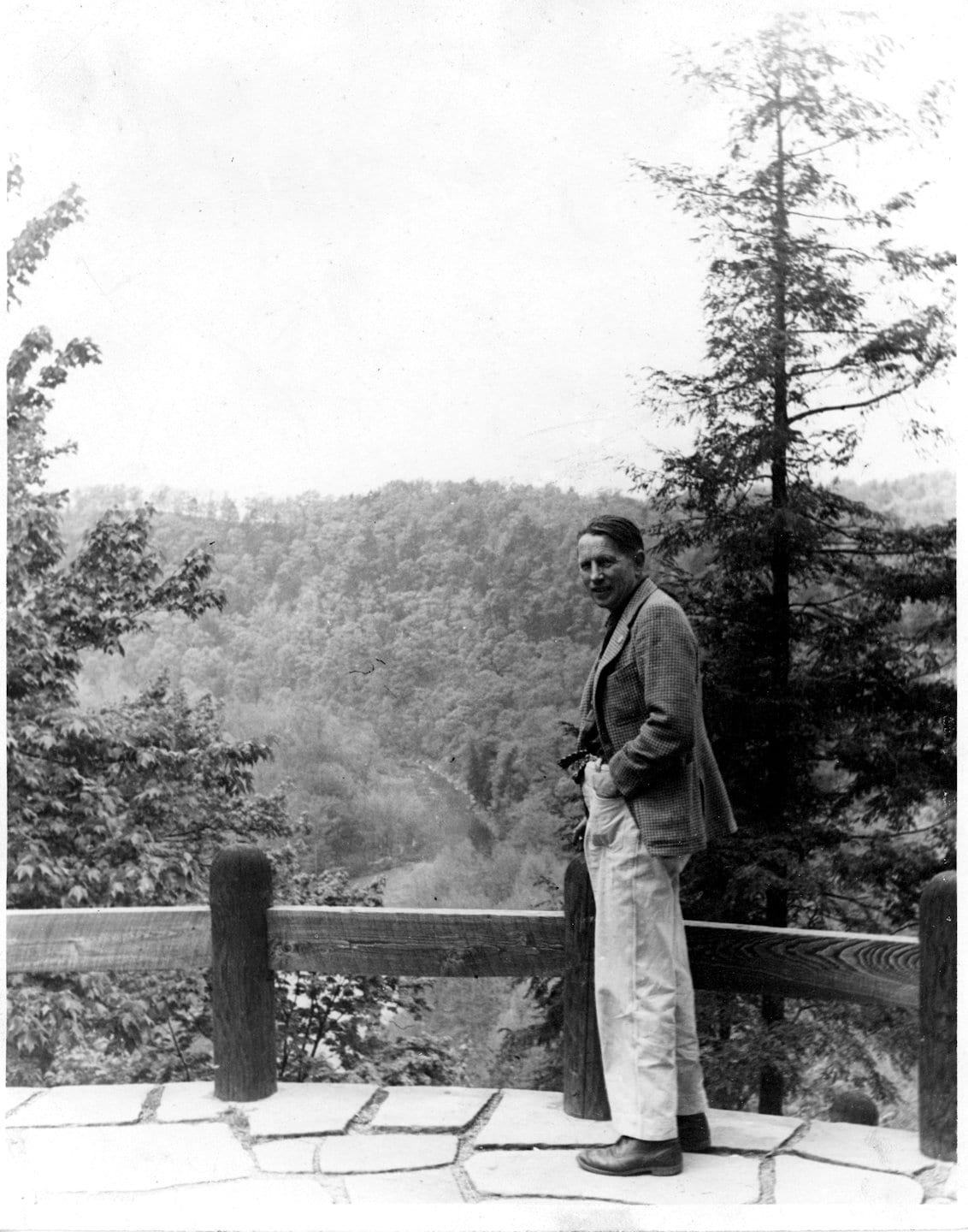
Phoebe Wise (1851-1933)
Louis Bromfield first met Phoebe Wise, a distant relative as a young boy while living in Mansfield, Ohio. The two hit it off together sharing a connection to the natural world and love of animals. Bromfield’s lasting impression of her was reflected in the fact that Louie wrote about this strange hermit-like woman, in his prize winning story “The Wedding Gown”, being ill for months; she was attended by old neighbors and kind persons who knew of her helplessness and loneliness. Bromfield used this character many times in his writings during his career as a novelist.
Phoebe Wise was an unusual and complex woman, known for her hermit-like lifestyle and independent ways. She was well-known and even liked in Mansfield – but two notorious and violent events turned her life upside down and her legendary fame. Her mother and father, both well educated and well born, died when Phoebe was quite young. A brother and sister, Frank and Ella Wise are said to have been educators, connected with state universities. Phoebe herself began teaching school in Richland county when she was only 14 years old. She was also an accomplished piano player well-versed in classical music.
Wise never married and gave a newspaper quote: “I don’t like men…they’re not truthful…I don’t look to humans for my happiness; people are too treacherous.” She preferred the love of animals over people. Many Mansfield locals believed that she was “touched” – “teched” not quite normal by society standards of the day. Phoebe lived outside town, kept to herself and found solitude in her life in the natural world, surrounded by her love of animals and nature.
She was quite a celebrity by local standards, having survived a vicious break-in and attempted burglary plus being stalked by an unwanted admirer as well. In December of 1891, three armed men broke into her house looking for the “family treasure” rumored to be hidden there. She was tied to a chair, and when Wise told them there was no treasure, her feet were burned with a torch, trying to torture the location of the treasure. After they ransacked her house, and found nothing but some jewelry. They fled the scene, leaving her tied to the chair. Wise was able to free herself and contact the local police. Recovering from her injuries she was left with a limp for the rest of her life.
One relentless new admirer, Jacob Kastanowitz, was overly infatuated with Phoebe. His pursuit led to his arrest and a stay in an asylum. But on the night of May 22, 1898, crazed admirer Kastanowitz showed up at her house, attempting to “break through a window” and hysterically demanded “Marry me or shoot me!” Wise fired a single rifle shot through the window in his direction, the next morning she found Jacobs body on the ground. A public hearing was held, at which Wise declared “I’m not guilty”, and refused to answer further questions. The prosecutor declared a case of “justifiable homicide” and declined to press charges against Phoebe. It seemed everyone in the City of Mansfield was on the side of Phoebe.
Phoebe Wise died at her home early in the morning of March 13, 1933. As a “local legend” from Mansfield, Phoebe Wise’s story is still being told even today.
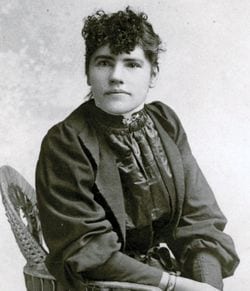
Phoebe Wise young photo 
Phoebe Wise older photo




